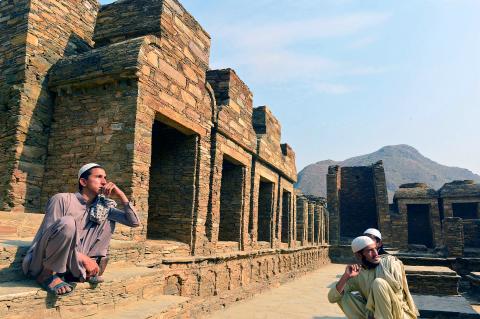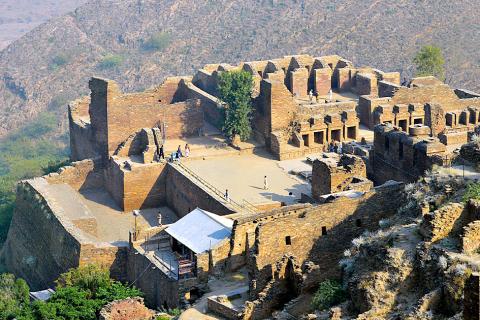Religious violence may be on the rise and the Taliban still a threat, but Pakistan is hoping a rich Buddhist heritage will help it boost international tourism to its troubled northwest.
Khyber Pakhtunkhwa Province, with its balmy climate in the mountains and its wealth of history on the border with Afghanistan, was once a playground for colonial adventurers and a favorite holiday destination for upper-crust Pakistanis.
Yet after the Sept. 11, 2001, attacks on the US ushered in war in Afghanistan and an insurgency against the Pakistani government, it has become synonymous with Pakistani Taliban and other Islamist militants who have killed thousands in recent years.

Photo: AFP
Wealthier Pakistanis and Westerners stopped visiting, scared away by attacks and the threat of being kidnapped, but the provincial government is now trying to lure thousands of visitors from wealthy Asian countries such as Japan and South Korea.
A group of about 20 Buddhist monks from South Korea made the journey to the monastery of Takht-i-Bahi, 170km from Islamabad, and close to the tribal areas that are a haven for Taliban and other Islamist militant groups.
“We really felt it is our hometown, it was a great feeling which it is not possible to describe in words,” Jeon Woon-deok, a senior South Korean monk, told reporters by e-mail of the visit last year. “We only regret that we waited so long to come here.”

Photo: AFP
The journey was no straightforward pilgrimage.
The monks defied appeals from Seoul to abandon their trip for safety reasons and were guarded by Pakistani security forces on their visit to the monastery, built of ocher colored stone and nestled on a mountainside.
From about 1000 BC until the seventh century AD, northern Pakistan and parts of modern Afghanistan formed the Gandhara Kingdom, where Greek and Buddhist customs mixed to create what became the Mahayana strand of the religion.
The monk Marananta set out from what is now northwest Pakistan to cross China and spread Buddhism on the Korean Peninsula during the fourth century.
The gardens of Takht-i-Bahi host picnicking families and daydreaming teenagers, as well as students from nearby Qoranic schools, but foreign visitors are rare.
“There used to be foreign tourists here in the past, but after the attacks there are hardly any,” local guide Iftikhar Ali said.
The flow of adventurous tourists from East Asia is no more than a trickle at the moment — Ali said he sees only one or two visitors a month on average.
“For them this place is like Mecca,” said Zulfiqar Rahim, the head of the Gandhara Art and Culture Association, which is dedicated to the promotion of Pakistan’s Buddhist heritage.
Last year, monks from Bhutan also came to visit, but the Pakistani government wants to boost numbers quickly.
“We are currently working to promote religious and archaeological Buddhist tourism,” Khyber Pakhtunkhwa’s Deputy Minister of Tourism Syed Jamaluddin Shah said.
The Pakistani authorities are even planning package tours for visitors from China, Japan, Singapore and South Korea, including trips to the Buddhist sites at Takht-i-Bahi, Swat, Peshawar and Taxila, near Islamabad.
“The tourism potential is enormous. If each person who comes spends US$1,200 with hotel costs and all the rest, and 1 million people come, that makes 1 billion dollars,” Rahim said, “And we’re not talking about 1 million people, but 50 million Mahayana Buddhists in Korea, China and Japan.”
However, there is a long way to go. It will be difficult to overcome huge security problems, poor tourist infrastructure and the challenges of getting a visa and permission to travel to high-risk areas.
Enormous floods in 2010 caused further damage, although the US has since provided US$5.4 million to help revive the local economy and rehabilitate tourism in the province’s Swat District.
For now, it is mostly local visitors who come to the remains of the Buddhist sites in Pakistan. Reflecting on his country’s woes, Sajjad, a teacher gazed at a statue of Buddha and sighed: “We need this calm so much.”

MULTIFACETED: A task force has analyzed possible scenarios and created responses to assist domestic industries in dealing with US tariffs, the economics minister said The Executive Yuan is tomorrow to announce countermeasures to US President Donald Trump’s planned reciprocal tariffs, although the details of the plan would not be made public until Monday next week, Minister of Economic Affairs J.W. Kuo (郭智輝) said yesterday. The Cabinet established an economic and trade task force in November last year to deal with US trade and tariff related issues, Kuo told reporters outside the legislature in Taipei. The task force has been analyzing and evaluating all kinds of scenarios to identify suitable responses and determine how best to assist domestic industries in managing the effects of Trump’s tariffs, he

TIGHT-LIPPED: UMC said it had no merger plans at the moment, after Nikkei Asia reported that the firm and GlobalFoundries were considering restarting merger talks United Microelectronics Corp (UMC, 聯電), the world’s No. 4 contract chipmaker, yesterday launched a new US$5 billion 12-inch chip factory in Singapore as part of its latest effort to diversify its manufacturing footprint amid growing geopolitical risks. The new factory, adjacent to UMC’s existing Singapore fab in the Pasir Res Wafer Fab Park, is scheduled to enter volume production next year, utilizing mature 22-nanometer and 28-nanometer process technologies, UMC said in a statement. The company plans to invest US$5 billion during the first phase of the new fab, which would have an installed capacity of 30,000 12-inch wafers per month, it said. The

Taiwan’s official purchasing managers’ index (PMI) last month rose 0.2 percentage points to 54.2, in a second consecutive month of expansion, thanks to front-loading demand intended to avoid potential US tariff hikes, the Chung-Hua Institution for Economic Research (CIER, 中華經濟研究院) said yesterday. While short-term demand appeared robust, uncertainties rose due to US President Donald Trump’s unpredictable trade policy, CIER president Lien Hsien-ming (連賢明) told a news conference in Taipei. Taiwan’s economy this year would be characterized by high-level fluctuations and the volatility would be wilder than most expect, Lien said Demand for electronics, particularly semiconductors, continues to benefit from US technology giants’ effort

ASML Holding NV, the sole producer of the most advanced machines used in semiconductor manufacturing, said geopolitical tensions are harming innovation a day after US President Donald Trump levied massive tariffs that promise to disrupt trade flows across the entire world. “Our industry has been built basically on the ability of people to work together, to innovate together,” ASML chief executive officer Christophe Fouquet said in a recorded message at a Thursday industry event in the Netherlands. Export controls and increasing geopolitical tensions challenge that collaboration, he said, without specifically addressing the new US tariffs. Tech executives in the EU, which is